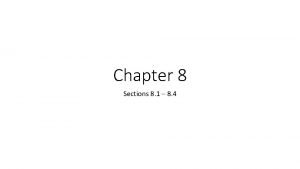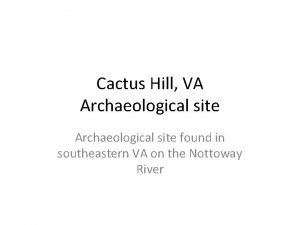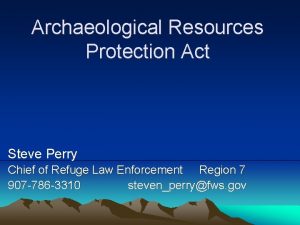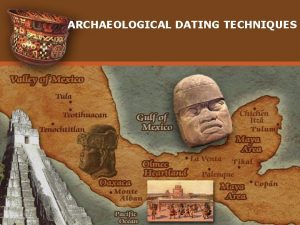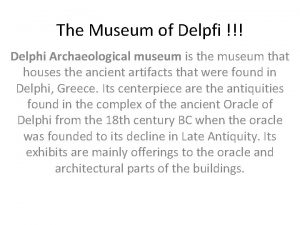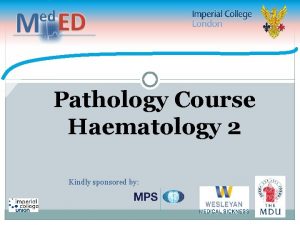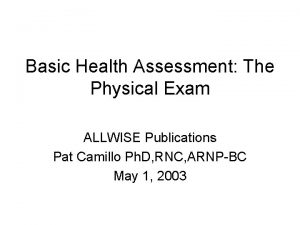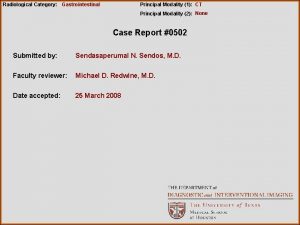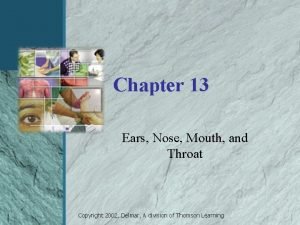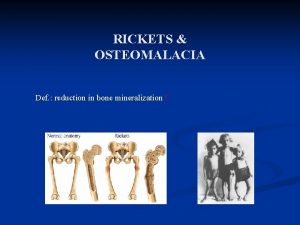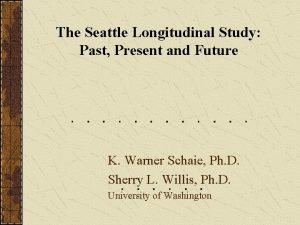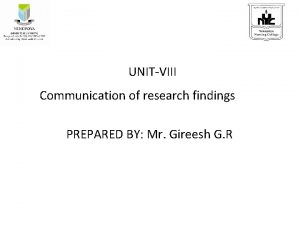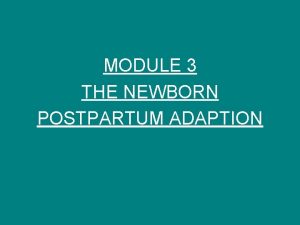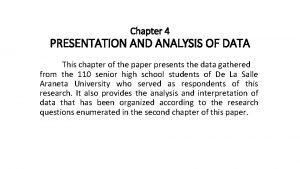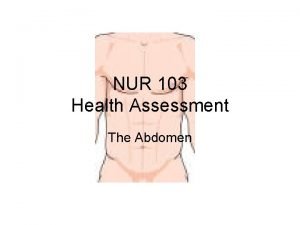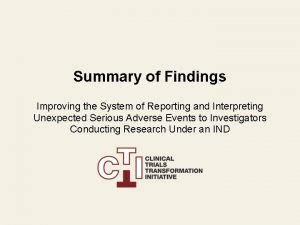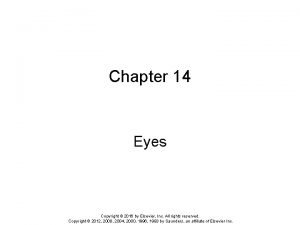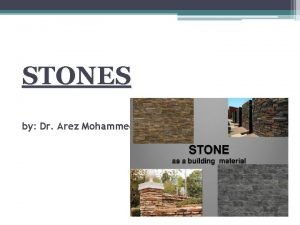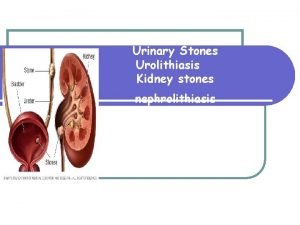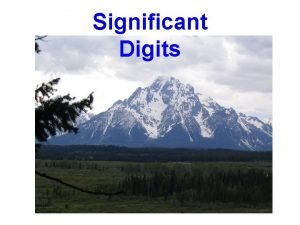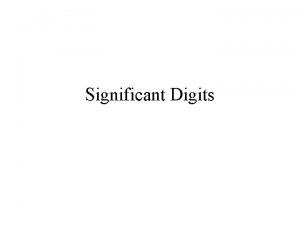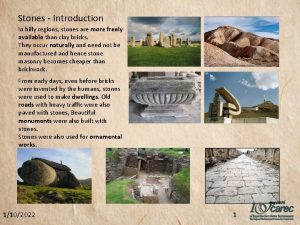Some Significant Archaeological Findings References The Stones Cry


























































- Slides: 58

Some Significant Archaeological Findings

References § “The Stones Cry Out” by Randall Price § “Scientific Evidences of the Bible’s Inspiration” by Bert Thompson (Apologetics Press) § “Ready with an Answer” by John Ankerberg and John Weldon § “Digging for Answers” by Garry K Brantley (Apologetics Press)

From the Old Testament Period

Genesis Corroboration from extra-biblical sources § From the library of king Ashurbanipal of Assyria in 668 -626 BC l l Resemblance of the Genesis Creation in the Babylonian creation myth (Enuma Elish) Resemblance of the Genesis Flood in the Babylonian flood epic (Gilgamesh Epic) § From a Chaldean monument: a record resembling the Genesis account of the Tower of Babel

Abraham § Abraham and the patriarchs and the city of Ur (discovered in 1922) (Genesis 11: 28 -31) § The five cities of the plain (Genesis 14: 2), as well as scores of other cities mentioned in the Bible § Abraham’s rescue of Lot in Genesis 14

Sodom & Gomorrah § Considered by many to be myth or legend § Cities of Sodom & Gomorrah discovered confirms their mentioned in the Ebla tablets in 1975 actual existence § Discovery of site in 1924 known as Bab edh-Dhra, by prominent archaeologist W F Albright, in the region where Sodom was expected to be located

Sodom & Gomorrah Excavations from 1965 discovered: § Site had faced extensive destruction by fire and covered by thick layer of ash § Evidence of fire having fallen above and burned through the roof from § Also discovered other sites in same region with similar evidence of extensive destruction by fire and ash possibly the other three cities of the plain including Gomorrah which were also similarly destroyed

Culture & Background Information on contemporary customs Tablets Discovered Period Ebla Significance 1976 2400 BC Historical background Mari 1933 1800 BC Historical background Nuzi 1500 BC Social customs 1931 Amarna 1887 1500 BC Ugarit 1929 1500 BC literature Mescha 1868 Conditions in Palestine Canaanite religion & 850 BC relationship Moabite-Israelite

Culture & Background Nuzi Tablets § Large number of cuneiform tablets § Explains why Laban was so concerned about the missing idols (Genesis 31: 19, 30) - could be token of promise from father-in-law to bequeath property to him § Records the use of straw in brick-making (Exodus 15: 13 -18) § Explains Sarai’s initiation for Abram to take Hagar to raise off-spring as her own (Genesis 16: 1 -3)

The Exodus § Liberals, including Jewish ones, deny the Exodus ever took place - just a compilation of old legends and distorted memories of what had happened § But Exodus is of primary theological importance in the Bible - crucial part of God’s plan for man’s redemption § No direct evidence so far, but several indirect evidences show the Bible account is true to the times

The Exodus Examples of indirect evidence § Writer has first-hand knowledge of Egyptian court life and practices § Foreigners from Canaan did enter Egypt and live in § Egypt oppressed and enslaved a large foreign workforce for several dynasties § Egypt did suffer from plagues Tel-el. Amarna texts and Ipuwer papyrus recorded plague of blood, cattle disease, fire phenomena, strange darkness

The Exodus § Evidence of mass movement of people and very large campsites in the Sinai § Explains why the Exodus route did not take the straightforward northern route toward Canaan - because there were several fortresses belonging to the Philistines and Egyptians

The Hittite Nation § Often mentioned in the Bible (eg Joshua 1: 4, 2 Kings 7: 6) § But evidence of the existence of the Hittite nation never discovered - hence doubted § In 1906 Hugh Winckler excavated the Hittite capital of Boghazkoy and discovered thousands of Hittite texts

The Conquest § Minimalists allege the Israelite conquest of Canaan led by Joshua never occurred l l Canaan was taken over by peaceful infiltration after a long period of uneasy coexistence Canaan taken over by a peasant revolt involving a liberation movement of the oppressed who became the Israelites § Above theories reached because archaeologists have found little evidence of a conquest of the land

The Conquest Important Bible facts about the Conquest § Joshua led Israel to conquer Canaan and the conquest was completed according to all that God had promised (Joshua 21: 43 -45) § It was a slow and long process (Deuteronomy 7: 22 -23, Joshua 11: 18, 23, 13: 1) § It did not leave a trail of violent destruction - very few cities were destroyed (Joshua 11: 13) § It involved a reluctant people (Joshua 18: 3)

The Conquest § Israel gradually lost control of the land because of their unfaithfulness to God, leading to uneasy coexistence with the native people of the land (Judges 1: 1 -3: 6) § Hence, there was no blitzkrieg conquest § Archaeological evidences of such will be absent - in fact, absence of such data confirms the Bible version § Evidences must be interpreted with above facts otherwise will lead to false theories

The Conquest § Bible chronology establishes the conquest of Canaan to be in the 15 th century BC § Minimalists allege the conquest took place in 13 th century BC § A number of evidences supporting the Bible chronology

The Conquest Merneptah Stela § Discovered in 1896 § Origin ~1210 BC § Poetic praises of king Merneptah of Egypt § Mentions “Israel” by name § Classifies Israel in same category as Hittites, implying by 1200 BC Israel was already an established power in the region equal to the Hittites

The Conquest Amarna Tablets § Discovered in 1887 § Origin ~1400 -1370 BC § Collection of letters of international correspondence (380 tablets) § Reveals political/military situation during that period § Include letters requesting for Egyptian assistance against the “Habiru” (=Hebrew? ) invaders

King David § Critical figure in the Bible “Son of David” Jesus called § Liberals claim that David never existed because evidence of his existence has not been found - David was simply a myth to describe the ideal king for Israel § Possible reasons for lack of direct evidence: l l Israel’s records were written on papyrus which do not preserve well Several sites which would most probably contain direct evidences are politically sensitive and hence inaccessible

King David Evidence discovered in 1993 § Aramaic inscriptions on a Syrian monument contain these words: “House of David”, referring to the defeat of a king of the Davidic dynasty § Hence, existence of David must be historical to have a dynasty after him § Moabite Stone also found to contain these letters: “House of D……” - could this also be David? All the data is not in yet!

King Solomon § The existence of Solomon’s reign and his thousands of horses (1 Kings 10: 2629) l From excavations in Meggido

King Omri § The Moabite Stone origin dated around 850 BC in the reign of king Mesha of Moab § Found in 1868 by a German missionary § Records the king being subjected to the Israelites § Mention of Omri as commander of the Israelite army (see 1 Kings 16: 16) § Confirms the Moabite rebellion after Ahab’s death (2 Kings 3: 4 -5)

King Jehoash The ten lines of Phoenician script describes King Jehoash's orders “to buy quarry stones and timber and copper and labour to carry out the duty with the faith” in repairing the First Temple

King Sargon § Mentioned once in the Bible in Isaiah 20: 1 § Existence doubted for many years § Discovered in 1843 in excavations in Mesopotamia when his entire palace was unearthed

King Belshazzar § Bible speaks of king Belshazzar (Daniel 5: 22, 7: 1, 8: 1) § But Belshazzar failed to appear in any historical record § Until 1876 when Sir Henry Rawlinson discovered 2000 tablets concerning Babylon - Belshazzar became king in the absence of his father Nabonidus

The Captivity & Exile of Judah § Babylonian Chronicles discovered in 1956 record capture of Jerusalem in 597 BC and history of period § Ezekiel’s dating of events by the years of king Jehoiachin’s captivity (Ezekiel 1: 1, 8: 1) l In 1930, record discovered mentioning Jehoiachin as a prisoner

The Restoration of Judah § The time of Nehemiah’s return and Sanballat and Tobiah as his enemies (Nehemiah 2: 1, 10, 19, 4: 1 -3, 7 -8, 6: 1 ff) § The drachma coin of Nehemiah (Nehemiah 7: 70)

From the New Testament Period

Historicity of Jesus Christ § Josephus referred not only to the Person of Jesus Christ and His character, but also to the circumstances surrounding His crucifixion under Pilate - and His resurrection three days later § Tacitus also referred to Jesus as a historical Person § Jesus Christ referred to in other secular literature Answers the question “Did Christ exist? ”

Historicity of Jesus Christ § But question remains: does Jesus Christ of the New Testament exist? § Referring to Jesus Christ, Rudolph Bultmann claimed: “All that remains of Jesus is an eschatological call to decision; the picture of His person and work has disappeared. ” § Jesus Seminar aims to separate “Christ of faith” from the “Christ of fact”

Historicity of Jesus Christ § Archaeology can provide some answers: if record of New Testament is also accurate like the Old Testament record, then there is much less reason to doubt the entire record § Archaeology has unearthed numerous evidences that support the accuracy of the New Testament record - too numerous to name

Archaeological Evidences § The census at the time of Christ’s birth (Luke 2: 1 -3) § King Herod of the Gospels (Herod the Great ostraca, 1996) § Jacob’s well (John 4: 5 -6) § Pool of Siloam (John 9: 1 -41) (1897) § Pool of Bethesda (John 5: 1 -15) (1903) § Jewish sects in the NT period (Dead Sea Scrolls, 1947 -1993)

Archaeological Evidences § Herod’s Temple and winter palace (Luke 1: 9, Matthew 2: 4) § Crucifixion at means of capital punishment (Remains of crucifixion, 1968) § Historicity of Pontius Pilate (Pilate Inscription, 1961) § Caiaphas, the High Priest at the trial of Jesus (Caiaphas Ossuary, 1990) § Destruction of the Temple in A. D. 70 (Arch of Titus & Vespasian-Titan Inscription, 1970)

Book of Acts § Sergius Paulus as the pro-consul of Paphos (Acts 13: 6 -7) § The relationship between Iconium, Lystra and Derbe (Acts 14: 6) § The district of Macedonia (Acts 16: 12) § The magistrates of Philippi (Acts 16: 20) § The altar to the “unknown God” (Acts 17: 23) in Athens

Book of Acts § Place where Paul stood before Gallio (Acts 18: 1217) (Bema Seat, 1935 -37) § Artemis’ temple, statues and altar (Acts 19: 27 -28, 35) § The Ephesian theatre and Golden House of Nero (Acts 19: 29, 25: 10, 1 Peter 2: 13) § Name and title of city treasurer Corinth (Romans 16: 23) Inscription, 1929 -1947) of (Eratus

Archaeological Evidences of Miracles

Authenticity of the Miraculous § Archaeological evidences cannot prove the miracle of Bible prophecies § But can provide authentication of the historicity of events § Apply to miraculous events § Also apply to prophecies

Examples of Miraculous Events A few examples of historical miraculous events with archaeological evidences: § The massive destruction by fire of the cities of the plain including Sodom and Gomorrah § Jericho’s tumbling walls l Based on discoveries in the 1950’s by minimalists Kathleen Kenyon, and reinterpreted by Archaeologist Bryant Wood § Hezekiah’s narrow escape from Assyrian destruction

The Walls of Jericho Did the walls come tumbling down? The evidences: § Jericho had impressive defence system § A retaining wall and embankment - but no wall! § Large deposit of bricks outside the retaining wall forming a sloping incline down to the ground level consistent with expectations if wall had collapsed - outwards!

The Walls of Jericho § Wall fell before city was set on fire § Unusually large quantity of stored grain - why was store not pillaged before city destroyed? (see Joshua 6: 18) § City fell shortly after the harvest (see Joshua 3: 15) Example of consistency when evidences are interpreted with Bible facts as key

Hezekiah’s Narrow Escape § The Assyrians under king Sargon II had destroyed Israel (2 Chronicles 30: 25) § Successor, Sennecherib, continued path of brutal conquest and threatened Judah l Inscriptions discovered boasts of Sennacherib laying waste to large districts of Judah § Yet, Hezekiah, a king who was faithful to God, led Judah to rebel against the Assyrian oppression (2 Kings 18: 7)

Hezekiah’s Narrow Escape § Assyrians laid seige on Jerusalem (2 Kings 18: 17) § Hezekiah took defensive measures against a very powerful enemy l l Diverted water resources (2 Chronicles 32: 2 -4, 30) Built up the fortifications of Jerusalem in haste using stones from houses (2 Chronicles 32: 5, Isaiah 22: 10) § Archaeological evidences that all the above are historical events

Hezekiah’s Narrow Escape § All desperate measures against the might of the Assyrians - Hezekiah turned to God (2 Chronicles 32: 20) § God promised to deliver Hezekiah and Judah (2 Kings 19: 7 ff) l Will cause Sennacherib to return suddenly to his own land l Will make him perish in his own land l Jerusalem will not fall to his hands § Bible records fulfillment of God’s promise (2 Kings 19: 35 -37)

Hezekiah’s Narrow Escape History records: § Assyrian record (The Taylor Prism) confirms l l l Hezekiah did rebel against Sennacherib led successful punitive campaigns against Judah Recorded a siege of Jerusalem - but no mention of its capture, implying either a stalemate or defeat § Sennacherib was assassinated by one of his sons in 681 BC (The Babylonian Chronicle)

Bible Prophecies § Archaeology has special role to provide evidences for divine prophecies § Provides evidences of historical prophesied in the Bible events § Provides evidences of the period of origin of the books of prophecy in the Bible - as answer to skeptics who claim they were written “ex post facto”

Examples of Prophecies A few examples of fulfilled prophecies with archaeological evidences: § the destruction of Israel § the destruction and restoration of Judah § the destruction of Tyre § the 4 world empires preceding the coming of the Messiah § the coming of Christ § the destruction of the Temple in AD 70

Archaeology and Bible Criticism

Dating the Books § Accurate and detailed knowledge of conditions, background and setting of the period described in the books and confirmed by archaeology l Political condition l Cultural, architectural, customs l Knowledge of individual personalities § Comparative study against writings of the same period l Words, phrases and language used l Style of writing

J-E-D-P § “Documentary hypothesis” Wellhausen theory) rejects author of the five (Graf- Moses as Law books § Claims books were compiled by variety of authors who wrote documents referred to as “J”, “E”, “D” and “P”, and compilation later reshuffled by editors § Claims Pentateuch essentially a work of post-exile period - not 15 th century BC § Theory has been taught for >100 years

J-E-D-P § No scrap of archaeological evidence to support J-E -D-P theory § On contrary, has been disproved for decades but continues to be taught as truth - so as to retain the paradigm that the Bible is or human and not divine origin § In 1979, words from Numbers 6: 24 -26 found in a silver amulet dating to time of Jeremiah in 600 BC

Dating the Books Psalms of David is a 10 th century BC work § Liberals assert most Psalms composed after the Exile § Ugarit tablets from the 14 th century BC contain poetry with style, forms and expressions similar to the Psalms § Hence, Psalms belong to time around 14 th century BC - not post-exile

Dating the Books § Book of Isaiah and Jeremiah are 8 th century BC and late 7 th century BC works respectively § Books of Daniel and Ezekiel are 6 th century BC works § Above find verification in the Dead Sea Scrolls l If books are late works, they would not have been included in the Dead Sea Scrolls by the conservative Qumran community

Dating the Books The Synoptic Gospels § Theories of form criticism claim that the Gospels were invented and written down 100 -150 years after the apostles passed away § However, historical details in the Gospels, confirmed by Bible Archaeology, show authors had intimate knowledge of the times - hence, date of origin cannot be far removed from the period they are concerned with

The Dead Sea Scrolls § Described as the most revolutionary archaeological finding ever made § Expected by critics to produce a radical revision of the Bible § Result is the opposite - they verified the reliability and stability of the Old Testament in the modern versions § “Accidental” discovery of scrolls involve very fortuitous circumstances

The Dead Sea Scrolls Value in dating the books § Critics assigned late dates (2 nd century BC) to books like Chronicles, Ecclesiastes, many of the Psalms, Daniel, but Scrolls provide evidence to refute such claims l Qumran community is extremely conservative - will not include recent books into their collection if they were not widely accepted as part of the Old Testament Canon § Critics accept much of the data except for Daniel, although evidence is of similar nature as for the other books. Why?

The Dead Sea Scrolls “The discovery of the Dead Sea Scrolls has made a contribution toward confirming the integrity of the biblical text and its own claim to predictive prophecy. ” (Dr J Randall Price)

Scholastic Hypocrisy Liberal critical scholarship guilty of hypocrisy § When archaeology appears not to confirm the Bible record, liberals will allege that the Bible is in error § When archaeology confirms the Bible, liberals avoid the finding § Stance taken in order to preserve their liberal views of the Bible
 Cry cry troy burns metrical feet
Cry cry troy burns metrical feet Why willy why do you cry
Why willy why do you cry Example of findings in research
Example of findings in research An archaeological dig turns up large numbers
An archaeological dig turns up large numbers Artifacts found at cactus hill
Artifacts found at cactus hill Archaeological resources protection act
Archaeological resources protection act Mortimer wheelar used scientific and soil layer method
Mortimer wheelar used scientific and soil layer method Archaeological museum of delphi
Archaeological museum of delphi Archaeological site of mycenae
Archaeological site of mycenae Gulf of mannar
Gulf of mannar What are some contact forces and some noncontact forces?
What are some contact forces and some noncontact forces? They say sometimes you win some
They say sometimes you win some Some say the world will end in fire some say in ice
Some say the world will end in fire some say in ice Some say the world will end in fire some say in ice
Some say the world will end in fire some say in ice God when you choose to leave mountains unmovable
God when you choose to leave mountains unmovable Some trust in chariots and some in horses song
Some trust in chariots and some in horses song Cake è countable or uncountable
Cake è countable or uncountable How to describe results
How to describe results Auscultate posterior thorax
Auscultate posterior thorax Myelofibrosis lab findings
Myelofibrosis lab findings Normal findings of skin
Normal findings of skin Pv miub
Pv miub Intussusception x ray findings
Intussusception x ray findings Mouth assessment normal findings
Mouth assessment normal findings To understand and interpret social interactions
To understand and interpret social interactions Site:slidetodoc.com
Site:slidetodoc.com Bristolian douglas rys
Bristolian douglas rys Reporting research findings
Reporting research findings Nutrition focused physical exam
Nutrition focused physical exam Megaloblastic anemia causes
Megaloblastic anemia causes Macrocytic anemia
Macrocytic anemia Desiredresults.us
Desiredresults.us Example of conclusion and recommendation in report
Example of conclusion and recommendation in report Causes of rickets
Causes of rickets Seattle longitudinal study findings
Seattle longitudinal study findings Marfan sign in rickets
Marfan sign in rickets Desired results parent survey
Desired results parent survey A level psychology specification
A level psychology specification Recommendation and conclusion example
Recommendation and conclusion example Donkey analogy heart failure
Donkey analogy heart failure Findings in research
Findings in research Presenting research findings
Presenting research findings Abnormal findings
Abnormal findings Translating research findings to clinical nursing practice
Translating research findings to clinical nursing practice Example of applied research
Example of applied research Vwf deficiency labs
Vwf deficiency labs Csf analysis
Csf analysis Example of result and discussion in qualitative research
Example of result and discussion in qualitative research Grade summary of findings table
Grade summary of findings table Chapter 4 data presentation and analysis
Chapter 4 data presentation and analysis Announcing your findings
Announcing your findings Aplastic anemia lab findings
Aplastic anemia lab findings Findings suggest that
Findings suggest that Normal bowel sound
Normal bowel sound Afib ecg reading
Afib ecg reading Summary of findings
Summary of findings Example of qualitative vs quantitative
Example of qualitative vs quantitative Findings and discussion
Findings and discussion Diagnostic positions test normal findings
Diagnostic positions test normal findings



